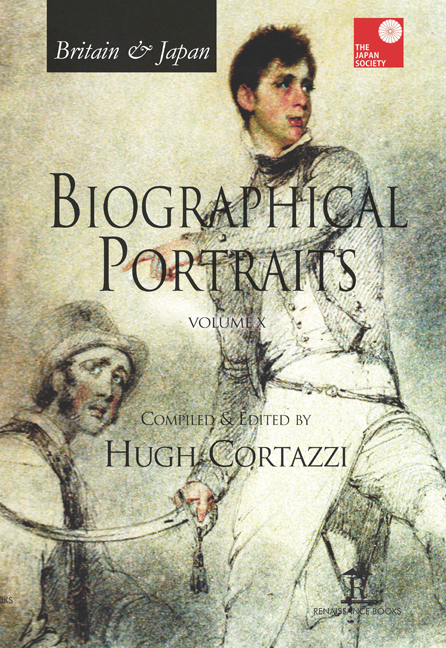Book contents
- Frontmatter
- Dedication
- Contents
- Introduction
- List of Contributors
- Index of Biographical Portraits in Japan Society Volumes
- PART I BRITAIN IN JAPAN
- PART II JAPAN IN BRITAIN
- Select Bibliography of Works in English on Anglo-Japanese Relations [Compiled by Gill Goddard – Retired East Asian Studies Librarian, University of Sheffield]
- Select Bibliography of Works in Japanese on Anglo-Japanese Relations [Compiled by Akira Hirano, SISJAC]
- Index
65 - Shimaoka Tatsuzō (1919–2007): Master Japanese Potter
Published online by Cambridge University Press: 07 May 2022
- Frontmatter
- Dedication
- Contents
- Introduction
- List of Contributors
- Index of Biographical Portraits in Japan Society Volumes
- PART I BRITAIN IN JAPAN
- PART II JAPAN IN BRITAIN
- Select Bibliography of Works in English on Anglo-Japanese Relations [Compiled by Gill Goddard – Retired East Asian Studies Librarian, University of Sheffield]
- Select Bibliography of Works in Japanese on Anglo-Japanese Relations [Compiled by Akira Hirano, SISJAC]
- Index
Summary
INTRODUCTION
SHIMAOKA TATSUZŌ WAS a Japanese master potter who in 1966 was officially designated an ‘Important Intangible Cultural Property’, more commonly known as a ‘Living National Treasure’. He was a pupil and close associate of Hamada Shōji, one of the founders with Yanagi Sōettsu and Bernard Leach of the Japanese Mingei (Folk Craft) movement. He lived and worked in the pottery village of Mashiko where his kiln was next door to that of Hamada. In later life he travelled widely in foreign countries visiting Britain on a number of occasions. There are fine examples of his pots in the British Museum and the Victoria and Albert Museum as well as the Sainsbury Centre in Norwich.
CAREER
Shimaoka was born in Tokyo in 1919. He was the son of a braid or rope-maker. A visit, which he made in 1938 to the Japanese Folk Craft Museum (Mingeikan) in Tokyo, founded by Yanagi Sōetsu, inspired him to become a potter. He chose to study ceramics at the Tokyo Institute of Technology where he enrolled in 1939 despite opposition from his father who wanted his son to follow in his footsteps as a braid maker. In the summer of 1939 he spent some time in Gifu prefecture learning how to use the potter's wheel. He graduated in 1941 with a degree in industrial ceramics, but had to enlist in the Imperial Japanese Army. He served in Burma in an engineering supply unit and when the war ended he became a prisoner of war.
On his return to Japan in 1946 his father's business was in ruins and he determined to become a potter working initially as an apprentice to Hamada Shōji who had set up in Mashiko in Tochigi prefecture in the 1920s. Shimaoka married in 1948 and worked for three years from 1949 at the Tochigi Prefecture Ceramic Research Centre before settling in 1953 in Mashiko. There he established his studio and workshop adjacent to that of Hamada. He also built his own five-chambered wood-fired climbing kiln (nobori-gama), which he fired for the first time in March 1954.
His pots have much in common in shape and technique with those of other Mingei style potters. But with Hamada's encouragement he developed his own designs and styles.
- Type
- Chapter
- Information
- Britain & Japan Biographical Portraits Vol X , pp. 745 - 753Publisher: Amsterdam University PressPrint publication year: 2016



